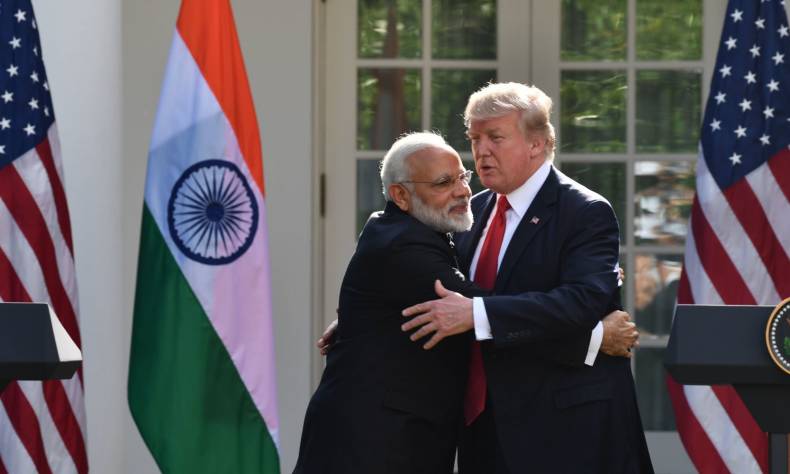
India Outgrows Its Britches in the Dong Lang Area (Doklam)
A month and a half have passed since the Dong Lang area incident broke out. Still, dozens of Indian border troops remain illegally in Chinese territory along some equipment. What on earth would give India the confidence to invade Dong Lang area and perhaps plunge into another border war with China?
By Ye Hailin
A month and a half have passed since the Dong Lang area incident broke out. Still, dozens of Indian border troops remain illegally in Chinese territory along some equipment.
Despite the fact that China and India are often cited together by Western media as evidence that the “21st Century belongs to Asia,” the two countries are far from equal in terms of overall national strength, military capacity and international status.
Even though India has invested enormous resources in maintaining its frontier advantage along the China-India boundary in past decades, changes in living conditions of Indian residents in the border areas remain negligible, especially compared to the tremendous changes that accompanied crucial infrastructure projects benefiting border residents on the Chinese side.
What on earth would give India the confidence to invade Dong Lang area and perhaps plunge into another border war with China?
The country’s ballooning confidence
Since the 1990s, India has indulged in the “fantasy” designed by Western media. After the Modi administration took power, India jumped to the top of the major emerging economies in terms of economic growth rate, overtaking China for several consecutive years. Despite the fact that the jump can be partially attributed to adjustments in India’s GDP statistical methods, the achievement still fueled India’s ambition to surpass China in economic size and quality. In this context, India began to take a “proactive” policy towards China.
Along with India’s fast economic growth, the Modi government’s arrogance is also fueled by the Indian politician’s good luck since he took office as the prime minister of India. For instance, India’s risky banknote demonetization plan at the end of 2016 eventually produced desirable outcomes, making the Modi administration believe it has all the answers.
However, confidence does not reflect actual economic and military power. In fact, India is clear about its tremendous shortcomings compared to China. Otherwise, India wouldn’t continue expressing hope to “peacefully resolve” the so-called “standoff” caused by its border troops entering Chinese territory. New Delhi has never made such expressions when wrestling with its traditional rival, Islamabad.
In fact, New Delhi’s brashness is largely fueled by its confidence in third-party players.
India believes that it enjoys a more favorable international and regional situation than China, which enables Indian leaders to rationalize away weaknesses. The Indian foreign minister told the parliament, “the whole world stands on our side.” Although that is a patently false statement, New Delhi prefers to believe it.
Of course, “the whole world” in this statement refers only to the Western world led by the United States, with hope that Russia would join them. It completely ignores and erases the small and medium-sized neighboring countries that have long lived in the shadow of India, never mind its long-term foe Pakistan.
In the opinion of New Delhi, Western countries see India as a major partner in constraining Beijing. Western obsession with containing China ensures India can enjoy more “freedom” in its disputes with China, including the freedom to violate international law and basic norms of the international community without fear of recourse.
Assuming that China would not take any countermeasures
Moreover,India believes that China is focused on so many different domestic and international issues that an incident in a corner of the Qinghai-Tibet Plateau would not demand major countermeasures.This is the real reason India dared provoke China through the Dong Lang area incident.
The think tank that suggested the Modi government instigate the Dong Lang area incident was consumed by strategically assuming that China would not take any effective countermeasures against India. Starting to believe in their fantasies has become the norm for Indian strategists.
As the document issued by the Chinese Ministry of Foreign Affairs on August 2 states, “No country should ever underestimate the resolve of the Chinese government and people to defend China’s territorial sovereignty.”
India has no option other than immediately withdrawing its trespassing border troops back into their own country. However, even if the troops vacate China tomorrow, India still cannot expect to survive the incident unscathed because full withdrawal of its trespassing troops is just the first prerequisite for resolving the incident, rather than all that China demands regarding the border dispute between the two countries.
If New Delhi doubts this, its parliament could spend some time examining the definition of “aggression” as well as the legal liabilities of an aggressor, as stipulated in UN documents. China’s demand is quite reasonable, especially considering that India is seeking to become a permanent member of the UN Security Council.
Ye Hailin is the director of the Editorial Department of South Asian Studies at the National Institute of International Strategy under the Chinese Academy of Social Sciences.
Source:China-India Dialogue
 Facebook
Facebook
 Twitter
Twitter
 Linkedin
Linkedin
 Google +
Google +











Can border disputes be displaced by win-win cooperation???
Do not look down upon any country. equal treat and mutual respect.
Correct! But this is based on mutual noninterference.